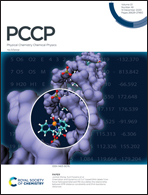Theoretical study on CO2 reduction catalyzed by formate dehydrogenase using the cation radical of a bipyridinium salt with an ionic substituent as a co-enzyme
Abstract
Formate dehydrogenase from Candida boidinii (CbFDH; EC.1.2.1.2) is a useful enzyme for CO2 reduction to formate in the photoredox system of a visible-light sensitizer and an electron mediator in the presence of an electron donor. The electron mediator, cation radicals of 4,4′-bipyridinium salts (4,4′-BPs) act as the co-enzyme for CbFDH in the CO2 reduction to formate. We found that the CbFDH-catalyzed CO2 reduction to formate could be controlled by the ionic substituents introduced into the cation radical of 4,4′-BPs [Y. Amao, Sustainable Energy Fuels, 2018, 2, 1928–1950]. By using 1,1′-diaminoethyl-4,4′-bipyridinium salt (DABP), 1-aminoethyl-1′-methyl-4,4′-bipyridinium salt (AMBP), 1,1′-carboxymethyl-4,4′-bipyridinium salt (DCBP), and 1-carboxymethyl-1′-methyl-4,4′-bipyridinium salt (CMBP), the introduction of an amino-group into 4,4′-BP accelerates the CbFDH-catalyzed CO2 reduction to formate, while the introduction of a carboxy-group into 4,4′-BP slows the CO2 reduction to formate. This work clarified the direct interaction of the cation radicals of DABP, DCBP, AMBP, CMBP, and MV in the substrate-binding site of CbFDH by the docking simulation. In addition, a mechanistic investigation for the CbFDH-catalyzed CO2 reduction to formate with cation radicals of DABP, DCBP, AMBP, CMBP, and MV was carried out based on the energy of molecular orbitals calculated by density functional theory (DFT).



 Please wait while we load your content...
Please wait while we load your content...